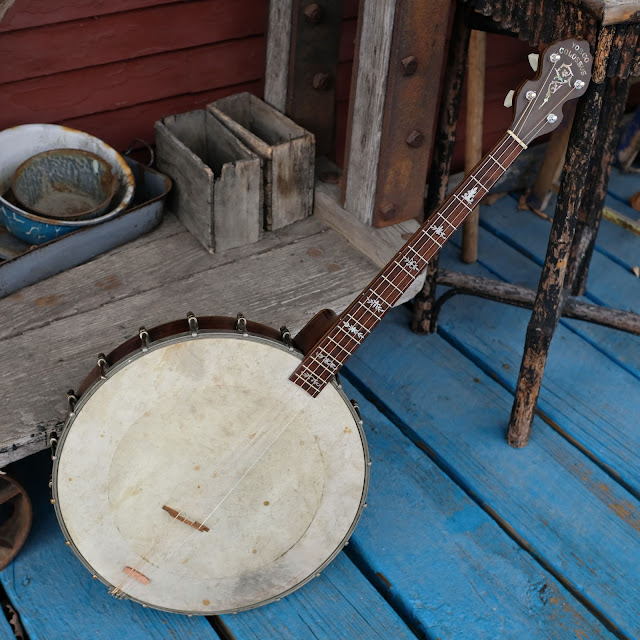1920s Yosco Colossus Tenor Banjo
This Yosco Colossus banjo was definitely up the food chain as far as quality goes. The neck is two-piece Brazilian rosewood, the board is the same, and the rim is veneered in the stuff as well. It has gobs of multi-ply yellow/green details including a face-plate and back-strap at the headstock, center-stripe on the neck, and trim under the fretboard and at the edges of the rim. It's deluxe.
While there are folks on the net talking about Yoscos being their own designs, I'm pretty firm in believing that this was made by Lange in New York -- the same maker as Paramount and Orpheum instruments. It has Lange DNA all over it in the way it was built, the hardware choices, heel shape and neck construction, fret and inlay style, and even the wood binding choice for the edges of the fretboard. If I hadn't seen the headstock and was told it was some sort of short-run Orpheum model, I wouldn't be surrprised.
Dating it is a little harder, though. I think that most of these big-rim, oddball tenor banjos (Vega went through this phase as well) were made in the late 1910s, but because I can't be certain, I'm giving it a "1920s" range.
This one was traded-in to me and while it has a few rough spots, I've gone-over it and given it a fret level/dress, repaired some seam/blocking separations at the rim, installed Gotoh UPT 4:1 geared pegs at the headstock, cleaned it up, and set it up. Aside from the pegs, it's entirely original save one antique nut (for one of the rim hooks) that's from my parts-bins.
It has a straight neck, plays perfectly with 1/16" action at the 12th fret, and I've set it up for "Celtic" or low GDAE tuning with gauges 42w, 30w, 20w, 12. The big, archtop-ish rim design gives it a full, warm voice for this pitch. Because the rim lacks a tonering or heavy duty hardware, the instrument is actually pretty lightweight for its size, too, and thus really comfortable to play.
Its one major flaw is that one section of its back rosewood resonator/cover bits is missing. I was thinking about replacing the missing section but decided to see how it would sound without it, so I went about fixing all the rest. I played it as it is right now and then also with the missing section taped-off (to simulate the missing bit being there) and it actually sounded better with the section left open as it exposed the outer-section of the double-rim construction to the air. It's a bit like unplugging a soundhole. In the end I just lightly-stained and sealed the exposed back edge to give it an older look and left it as-is.
Specs are: 21 3/8" scale, 1 1/8" nut width, 27/32" string spacing at the nut, 1 3/16" spacing at the bridge, 13 5/8" head diameter, and 3 1/4" depth.
Materials are: Brazilian rosewood neck and fretboard, maple(?) double-rim constriction with Brazilian rosewood veneers, original skin head, and all-original hardware save upgraded tuners and one nut from a hook/nut set. The maple bridge and the bone nut are original, too.
As is so typical with many period products, the headstock veneer is ebonized maple rather than rosewood or ebony.
You can see some faint scratched-in notation marks on the fretboard here and there. They're not obvious.
The leather pad on the outer section of head simply mutes the string-afterlength overtones.
Many folks may be surprised that the uke-centric Gotoh UPTs make great replacements for banjo friction pegs. They work the same as normal 4:1 geared banjo pegs but are smaller, lightweight, and more reminiscent of banjo friction pegs in their looks.
How about that backstapping of the headstock? Original that stuff would've been bright yellow and turquoise to offset the rich Brazilian rosewood of the neck. It still looks darn handsome, however.
The neck attaches Gibson-style with a bolt securing it firmly.
Here's the missing rosewood backplate's area. You can clearly see the double-rim constuction, here. I've added three additional vintage screws to help secure the blocking for the rim, too, as it was a little uneasy as-received. It's now nice and stable.
Rosewood all over, huh? That's a Brazilian rosewood fretboard with Brazilian rosewood binding over a Brazilian rosewood neck.























Comments